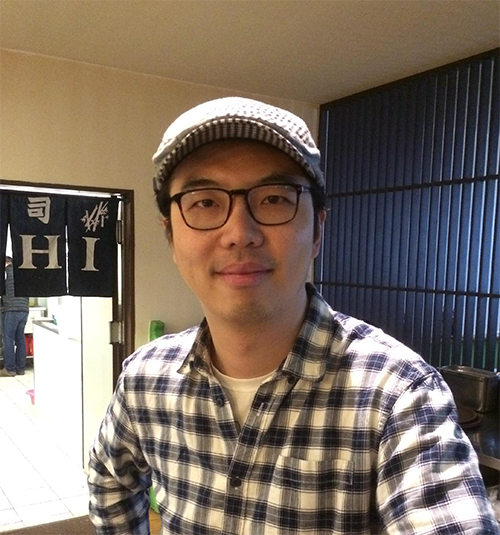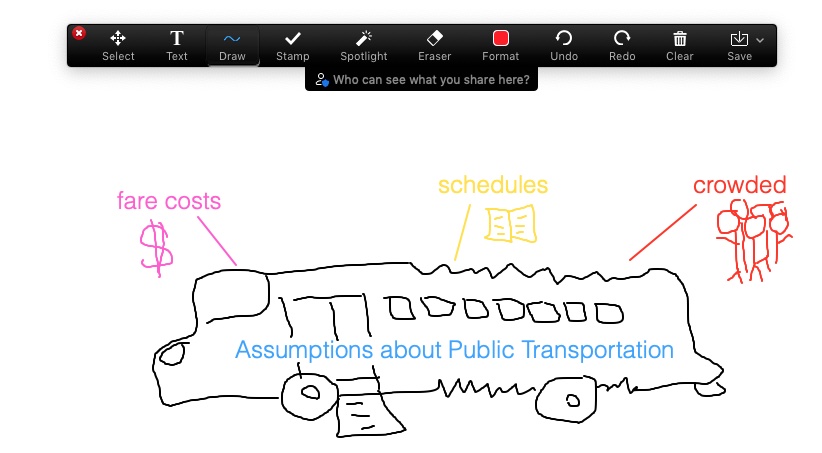
Day 7: Will Zhao's Collaborating through Visual Annotation
 | Name: Dr. Wenyao G.(Will) Zhao Area/Discipline: Management |
The Technique
I know there might be better technologies out there but, in an effort to be more equitable and cost efficient, I use Zoom as a platform for the technique I’m sharing because it is institutionally supported with no cost to students.
My class of students are from diverse backgrounds, and I believe that discussion combined with the technique -- visual-based collaborative annotation -- supports different forms of literacy, creating a visual and activity based experience. I’ve found that being online both allows for more diverse ways in which my learners can express themselves and supports creativity beyond language barriers. I use a visual-based collaborative annotation technique to tap into that.
The only application we need is Zoom, which allows the creation of collaborative breakout rooms of 5 to 6 people and which comes with built-in annotation features. In my class, I first demonstrate the annotation features to my students, and then I accompany them as they explore how they can jointly develop their product/project/solution via collaborative visual annotation.

Each group, by the end of the process, is able to submit a visual (with annotations) of a product prototype, service, or business model. The resulting submissions are rich in detail, and the students seem to be producing more creative works as a result.
One example is the Assumption Reversal Exercise that we often do when learning Innovation. Virtually all products, services, and solutions are designed and developed with a set of assumptions. Yet sticking to existing assumptions often creates barriers to creativity. Therefore, in this exercise, I ask my students to participate in a two-phase visualization activity around the following two questions:
- What are the assumptions around the proposed problem?
- What are sound reversed assumptions?
This exercise and experience has become foundational to their practicum phase that comes at the end of the entire course.
How I Use It
Let’s stick with the example of the Assumption Reversal Exercise and see if we can come up with innovative solutions that enhance sustainability. In my class, I first make a proposition for a problem that needs a solution (e.g. public transportation in Canada has some problems in regards to access, cost, and sustainability in general).
- As a whole class in our main Zoom room, we begin to discuss the factors to consider. At this point, I also create breakout rooms.
- Next, students are given the choice to move to a breakout room for discussion (with their project team) or to leave the Zoom session for a short period of time to meet privately with their team with the promise to return at the end of the fixed time period.*
- With this in mind, students make a choice and move to their preferred space with one student taking the “Host” role.
- Next, they Share Screen and select Whiteboard from the Share Screen options. This is an often forgotten tool built into Zoom that facilitates visual collaboration.
- From the bottom panel, the host goes to Security and selects “Annotate on Shared Content.” This allows all participants access to a set of tools which include drawing, text, and basic shape design.
- Now, it’s time for students to begin reversing assumptions for the proposed task by asking and answering oppositional questions (e.g., for buses: Why do we need to wait at a stop? Why is there a schedule? Why do we have to pay fees?). This questioning will help them to identify a list of assumptions they can now work to address in their design!
A set of assumptions for the public transport example
|
- They will draw out and/or add words/designs on the Whiteboard as they discuss the proposed problem until they have a full map/view of the proposition.
A set of reverse assumptions for the public transport example
|
- Once we have completed our annotation reversals, students must export each visual representation created with their group as a .pdf or a .png file and submit them to me for marking and feedback.
- An alternative option is for groups to leave and return after they have met (they can use a separate Zoom or a private meeting room of their choosing).
Feedback from Learners
“Dr. Zhao’s innovative approach really motivated us to step out of our comfort zone and start to be entrepreneurial and collaborative in start-up idea generation.”
“Despite the COVID-19, we virtually had a brick-and-mortar semester, thanks to Dr. Zhao’s collaborative way of online teaching.”
“A great and important subject in the MBA program, which shows how important team building and innovation are for an entrepreneur. Until the start of the term I felt I didn’t have the skills to think like an entrepreneur, but through this subject I could put forward different ideas amongst my team on weekly visual assignments.”
Supporting Goal 8
Promote inclusive and sustainable economic growth, full and productive employment, and decent work for all
By teaching students a systematic, low-cost, collaborative approach to challenging conventional assumptions in a wide range of areas (e.g., urban planning and other sustainability-related practices and solutions), this technique has great potential to grow a generation of creative thinkers who can create new and sustainable products, services and categories, and re-envision the communities in which we live.
A short task to challenge you!
One tradition for some families at this time of year is to buy/assemble a tree to decorate. Part of the tradition is to put the tree in the corner of a family room and then decorate it. Why must the tree be in the corner of your family room?
List another assumption that you know or have heard, for what is commonly referred to as 'christmas tree' (in column one) and then include a reverse assumption (in column two):
One Final Task
Is this something you can use in your classroom? How might you utilize it? If you share your results somewhere on social media, please let us know by using the hashtag: #12techLUDay7.
![]()
12 Techniques of the Holidays 2021 by Teaching Commons@LU is licensed under a Creative Commons Attribution-NonCommercial-ShareAlike 4.0 International License.

